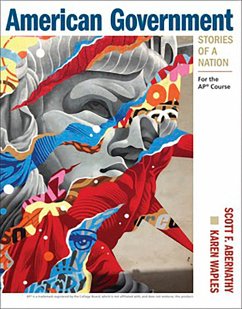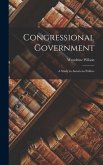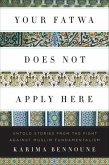- Gebundenes Buch
- Merkliste
- Auf die Merkliste
- Bewerten Bewerten
- Teilen
- Produkt teilen
- Produkterinnerung
- Produkterinnerung
¿his new offering from AP® teacher Karen Waples and college professor Scott Abernathy is tailor-made to help teachers and students transition to the redesigned AP® U. S. Government and Politics course. Carefully aligned to the course framework, this brief book is loaded with instructional tools to help you and your students meet the demands of the new course, such as integrated skills instruction, coverage of required cases and documents, public policy threaded throughout the book, and AP® practice after every chapter and unit, all in a simple organization that will ease your course planning and save you time. We've got you covered!…mehr
Andere Kunden interessierten sich auch für
![Congressional Government: A Study in American Politics Congressional Government: A Study in American Politics]() Woodrow WilsonCongressional Government: A Study in American Politics40,99 €
Woodrow WilsonCongressional Government: A Study in American Politics40,99 €![Graduate Education in Government Graduate Education in Government]() George VernardakisGraduate Education in Government79,99 €
George VernardakisGraduate Education in Government79,99 €![Your Fatwa Does Not Apply Here: Untold Stories from the Fight Against Muslim Fundamentalism Your Fatwa Does Not Apply Here: Untold Stories from the Fight Against Muslim Fundamentalism]() Karima BennouneYour Fatwa Does Not Apply Here: Untold Stories from the Fight Against Muslim Fundamentalism23,99 €
Karima BennouneYour Fatwa Does Not Apply Here: Untold Stories from the Fight Against Muslim Fundamentalism23,99 €![Stories from Langley Stories from Langley]() Stories from Langley34,99 €
Stories from Langley34,99 €![European Stories European Stories]() European Stories206,99 €
European Stories206,99 €![We Need New Stories We Need New Stories]() Nesrine MalikWe Need New Stories19,99 €
Nesrine MalikWe Need New Stories19,99 €![Stories of the Liberation Struggles in South Africa Stories of the Liberation Struggles in South Africa]() Thabo Israel PudiStories of the Liberation Struggles in South Africa34,99 €
Thabo Israel PudiStories of the Liberation Struggles in South Africa34,99 €-
-
-
¿his new offering from AP® teacher Karen Waples and college professor Scott Abernathy is tailor-made to help teachers and students transition to the redesigned AP® U. S. Government and Politics course. Carefully aligned to the course framework, this brief book is loaded with instructional tools to help you and your students meet the demands of the new course, such as integrated skills instruction, coverage of required cases and documents, public policy threaded throughout the book, and AP® practice after every chapter and unit, all in a simple organization that will ease your course planning and save you time. We've got you covered!
Hinweis: Dieser Artikel kann nur an eine deutsche Lieferadresse ausgeliefert werden.
Hinweis: Dieser Artikel kann nur an eine deutsche Lieferadresse ausgeliefert werden.
Produktdetails
- Produktdetails
- Verlag: Bedford Books / Macmillan Learning
- Seitenzahl: 640
- Erscheinungstermin: 10. Dezember 2018
- Englisch
- Abmessung: 277mm x 221mm x 25mm
- Gewicht: 1406g
- ISBN-13: 9781319195366
- ISBN-10: 1319195369
- Artikelnr.: 53068303
- Herstellerkennzeichnung
- Libri GmbH
- Europaallee 1
- 36244 Bad Hersfeld
- gpsr@libri.de
- Verlag: Bedford Books / Macmillan Learning
- Seitenzahl: 640
- Erscheinungstermin: 10. Dezember 2018
- Englisch
- Abmessung: 277mm x 221mm x 25mm
- Gewicht: 1406g
- ISBN-13: 9781319195366
- ISBN-10: 1319195369
- Artikelnr.: 53068303
- Herstellerkennzeichnung
- Libri GmbH
- Europaallee 1
- 36244 Bad Hersfeld
- gpsr@libri.de
Scott Abernathy; Karen Waples
Unit 1 Democracy and the Constitution
Chapter 1 American Government and Politics: The Stories of Our Nation
Section 1.1 The Fight for Students' Rights
Section 1.2 American Political Culture
Section 1.3 Competing Theories of Democracy
Section 1.4 Institutions, Systems, and Power
Chapter 2 The Constitution: A New Vision of Government
Section 2.1 The Articles of Confederation
Section 2.2 The Constitutional Convention
Section 2.3 Branches of Government
Section 2.4 Ratification: Federalists versus Antifederalists
Chapter 3 Federalism: Dividing Power between the National Government and
the States
Section 3.1 Conflict over Medical Marijuana
Section 3.2 Federalism and the Constitution
Section 3.3 The Dynamic Nature of Federalism
Section 3.4 Modern American Federalism
Section 3.5 The Supreme Court and Modern Federalism
Unit 1 Review
Unit 2 The Branches of the Federal Government
Chapter 4 Congress: Representation, Organization, and Legislation
Section 4.1 The Constitution and Congress
Section 4.2 Politics of Congressional Elections
Section 4.3 The Organization of Congress
Section 4.4 "I'm Just a Bill"
Section 4.5 Congress and the Budget
Section 4.6 Challenges of Representation
Chapter 5 The American Presidency: Individuals, Institutions, and Executive
Power
Section 5.1 Presidential Power and the War on Terror
Section 5.2 The Constitution and the American Presidency
Section 5.3 Limits on Presidential Power
Section 5.4 The Modern Presidency in Context
Section 5.5 The War on Terror and Presidential Power
Chapter 6 The Federal Judiciary: Politics, Power, and the "Least Dangerous"
Branch
Section 6.1 Judicial Independence from Money and Politics-Or Both
Section 6.2 The Constitution and the Federal Judiciary
Section 6.3 John Marshall and the Power of the Supreme Court
Section 6.4 Organization of the Federal Judiciary
Section 6.5 Judicial Review, Constitutional Interpretation, and
Judicial Decision Making
Chapter 7 The Federal Bureaucracy: Putting the Nation's Laws into Effect
Section 7.1 How the Bureaucracy Is Organized
Section 7.2 The Structure of the Modern Federal Bureaucracy
Section 7.3 The Bureaucracy and Policy Making
Section 7.4 Checks on the Bureaucracy
Unit 2 Review
Unit 3 Civil Rights and Civil Liberties
Chapter 8 Civil Liberties: Protecting Fundamental Freedoms
Section 8.1 The Constitution and the Bill of Rights
Section 8.2 Selective Incorporation
Section 8.3 The Right of Religious Freedom
Section 8.4 The Right of Expression and the Right to Own Firearms
Section 8.5 The Rights of Defendants
Section 8.6 Privacy and Other Rights
Chapter 9 Civil Rights: What Is Equality?
Section 9.1 Securing Rights for Those with Disabilities
Section 9.2 The Fight against Segregation
Section 9.3 The Civil Rights Movement
Section 9.4 The Fight for Women's Rights
Unit 3 Review
Unit 4 American Political Ideologies and Beliefs
Chapter 10 American Political Culture: What Americans Believe
Section 10.1 Core Political Values
Section 10.2 Political Socialization
Section 10.3 Globalization and American Core Values
Chapter 11 Public Opinion: Measuring Americans' Opinions
Section 11.1 What Is Public Opinion?
Section 11.2 Trying to Measure Public Opinion Accurately
Section 11.3 The Effects of Public Opinion on Democratic Representation
Chapter 12 Political Ideology
Section 12.1 Party Ideology
Section 12.2 Ideology and Fiscal Policy
Section 12.3 Monetary Policy
Unit 4 Review
Unit 5 Political Participation
Chapter 13 Elections and Campaigns: Candidates and Voters in an Era of
Demographic Change
Section 13.1 Forms of Political Participation
Section 13.2 Voting
Section 13.3 Elections and Democratic Representation
Section 13.4 The Politics of Presidential Elections
Section 13. 5 Money and Campaigns
Chapter 14 Political Parties: The Outsiders versus the Establishment
Section 14.1 Functions of Political Parties
Section 14.2 The Development of American Political Parties
Section 14.3 Parties and Political Campaigns
Section 14.4 Third Parties
Chapter 15 Interest Groups and Social Movements: Collective Action, Power
and Representation
Section 15.1 A Nation of Joiners
Section 15.2 Interest-Group Tactics
Section 15.3 Social Movements
Chapter 16 The Media: New Technologies, Enduring Issues
Section 16.1 The Evolving News Media
Section 16.1 Regulating Content and Ownership
Section 16.1 How the Media Shape American Politics Today
Unit 5 Review
Chapter 1 American Government and Politics: The Stories of Our Nation
Section 1.1 The Fight for Students' Rights
Section 1.2 American Political Culture
Section 1.3 Competing Theories of Democracy
Section 1.4 Institutions, Systems, and Power
Chapter 2 The Constitution: A New Vision of Government
Section 2.1 The Articles of Confederation
Section 2.2 The Constitutional Convention
Section 2.3 Branches of Government
Section 2.4 Ratification: Federalists versus Antifederalists
Chapter 3 Federalism: Dividing Power between the National Government and
the States
Section 3.1 Conflict over Medical Marijuana
Section 3.2 Federalism and the Constitution
Section 3.3 The Dynamic Nature of Federalism
Section 3.4 Modern American Federalism
Section 3.5 The Supreme Court and Modern Federalism
Unit 1 Review
Unit 2 The Branches of the Federal Government
Chapter 4 Congress: Representation, Organization, and Legislation
Section 4.1 The Constitution and Congress
Section 4.2 Politics of Congressional Elections
Section 4.3 The Organization of Congress
Section 4.4 "I'm Just a Bill"
Section 4.5 Congress and the Budget
Section 4.6 Challenges of Representation
Chapter 5 The American Presidency: Individuals, Institutions, and Executive
Power
Section 5.1 Presidential Power and the War on Terror
Section 5.2 The Constitution and the American Presidency
Section 5.3 Limits on Presidential Power
Section 5.4 The Modern Presidency in Context
Section 5.5 The War on Terror and Presidential Power
Chapter 6 The Federal Judiciary: Politics, Power, and the "Least Dangerous"
Branch
Section 6.1 Judicial Independence from Money and Politics-Or Both
Section 6.2 The Constitution and the Federal Judiciary
Section 6.3 John Marshall and the Power of the Supreme Court
Section 6.4 Organization of the Federal Judiciary
Section 6.5 Judicial Review, Constitutional Interpretation, and
Judicial Decision Making
Chapter 7 The Federal Bureaucracy: Putting the Nation's Laws into Effect
Section 7.1 How the Bureaucracy Is Organized
Section 7.2 The Structure of the Modern Federal Bureaucracy
Section 7.3 The Bureaucracy and Policy Making
Section 7.4 Checks on the Bureaucracy
Unit 2 Review
Unit 3 Civil Rights and Civil Liberties
Chapter 8 Civil Liberties: Protecting Fundamental Freedoms
Section 8.1 The Constitution and the Bill of Rights
Section 8.2 Selective Incorporation
Section 8.3 The Right of Religious Freedom
Section 8.4 The Right of Expression and the Right to Own Firearms
Section 8.5 The Rights of Defendants
Section 8.6 Privacy and Other Rights
Chapter 9 Civil Rights: What Is Equality?
Section 9.1 Securing Rights for Those with Disabilities
Section 9.2 The Fight against Segregation
Section 9.3 The Civil Rights Movement
Section 9.4 The Fight for Women's Rights
Unit 3 Review
Unit 4 American Political Ideologies and Beliefs
Chapter 10 American Political Culture: What Americans Believe
Section 10.1 Core Political Values
Section 10.2 Political Socialization
Section 10.3 Globalization and American Core Values
Chapter 11 Public Opinion: Measuring Americans' Opinions
Section 11.1 What Is Public Opinion?
Section 11.2 Trying to Measure Public Opinion Accurately
Section 11.3 The Effects of Public Opinion on Democratic Representation
Chapter 12 Political Ideology
Section 12.1 Party Ideology
Section 12.2 Ideology and Fiscal Policy
Section 12.3 Monetary Policy
Unit 4 Review
Unit 5 Political Participation
Chapter 13 Elections and Campaigns: Candidates and Voters in an Era of
Demographic Change
Section 13.1 Forms of Political Participation
Section 13.2 Voting
Section 13.3 Elections and Democratic Representation
Section 13.4 The Politics of Presidential Elections
Section 13. 5 Money and Campaigns
Chapter 14 Political Parties: The Outsiders versus the Establishment
Section 14.1 Functions of Political Parties
Section 14.2 The Development of American Political Parties
Section 14.3 Parties and Political Campaigns
Section 14.4 Third Parties
Chapter 15 Interest Groups and Social Movements: Collective Action, Power
and Representation
Section 15.1 A Nation of Joiners
Section 15.2 Interest-Group Tactics
Section 15.3 Social Movements
Chapter 16 The Media: New Technologies, Enduring Issues
Section 16.1 The Evolving News Media
Section 16.1 Regulating Content and Ownership
Section 16.1 How the Media Shape American Politics Today
Unit 5 Review
Unit 1 Democracy and the Constitution
Chapter 1 American Government and Politics: The Stories of Our Nation
Section 1.1 The Fight for Students' Rights
Section 1.2 American Political Culture
Section 1.3 Competing Theories of Democracy
Section 1.4 Institutions, Systems, and Power
Chapter 2 The Constitution: A New Vision of Government
Section 2.1 The Articles of Confederation
Section 2.2 The Constitutional Convention
Section 2.3 Branches of Government
Section 2.4 Ratification: Federalists versus Antifederalists
Chapter 3 Federalism: Dividing Power between the National Government and
the States
Section 3.1 Conflict over Medical Marijuana
Section 3.2 Federalism and the Constitution
Section 3.3 The Dynamic Nature of Federalism
Section 3.4 Modern American Federalism
Section 3.5 The Supreme Court and Modern Federalism
Unit 1 Review
Unit 2 The Branches of the Federal Government
Chapter 4 Congress: Representation, Organization, and Legislation
Section 4.1 The Constitution and Congress
Section 4.2 Politics of Congressional Elections
Section 4.3 The Organization of Congress
Section 4.4 "I'm Just a Bill"
Section 4.5 Congress and the Budget
Section 4.6 Challenges of Representation
Chapter 5 The American Presidency: Individuals, Institutions, and Executive
Power
Section 5.1 Presidential Power and the War on Terror
Section 5.2 The Constitution and the American Presidency
Section 5.3 Limits on Presidential Power
Section 5.4 The Modern Presidency in Context
Section 5.5 The War on Terror and Presidential Power
Chapter 6 The Federal Judiciary: Politics, Power, and the "Least Dangerous"
Branch
Section 6.1 Judicial Independence from Money and Politics-Or Both
Section 6.2 The Constitution and the Federal Judiciary
Section 6.3 John Marshall and the Power of the Supreme Court
Section 6.4 Organization of the Federal Judiciary
Section 6.5 Judicial Review, Constitutional Interpretation, and
Judicial Decision Making
Chapter 7 The Federal Bureaucracy: Putting the Nation's Laws into Effect
Section 7.1 How the Bureaucracy Is Organized
Section 7.2 The Structure of the Modern Federal Bureaucracy
Section 7.3 The Bureaucracy and Policy Making
Section 7.4 Checks on the Bureaucracy
Unit 2 Review
Unit 3 Civil Rights and Civil Liberties
Chapter 8 Civil Liberties: Protecting Fundamental Freedoms
Section 8.1 The Constitution and the Bill of Rights
Section 8.2 Selective Incorporation
Section 8.3 The Right of Religious Freedom
Section 8.4 The Right of Expression and the Right to Own Firearms
Section 8.5 The Rights of Defendants
Section 8.6 Privacy and Other Rights
Chapter 9 Civil Rights: What Is Equality?
Section 9.1 Securing Rights for Those with Disabilities
Section 9.2 The Fight against Segregation
Section 9.3 The Civil Rights Movement
Section 9.4 The Fight for Women's Rights
Unit 3 Review
Unit 4 American Political Ideologies and Beliefs
Chapter 10 American Political Culture: What Americans Believe
Section 10.1 Core Political Values
Section 10.2 Political Socialization
Section 10.3 Globalization and American Core Values
Chapter 11 Public Opinion: Measuring Americans' Opinions
Section 11.1 What Is Public Opinion?
Section 11.2 Trying to Measure Public Opinion Accurately
Section 11.3 The Effects of Public Opinion on Democratic Representation
Chapter 12 Political Ideology
Section 12.1 Party Ideology
Section 12.2 Ideology and Fiscal Policy
Section 12.3 Monetary Policy
Unit 4 Review
Unit 5 Political Participation
Chapter 13 Elections and Campaigns: Candidates and Voters in an Era of
Demographic Change
Section 13.1 Forms of Political Participation
Section 13.2 Voting
Section 13.3 Elections and Democratic Representation
Section 13.4 The Politics of Presidential Elections
Section 13. 5 Money and Campaigns
Chapter 14 Political Parties: The Outsiders versus the Establishment
Section 14.1 Functions of Political Parties
Section 14.2 The Development of American Political Parties
Section 14.3 Parties and Political Campaigns
Section 14.4 Third Parties
Chapter 15 Interest Groups and Social Movements: Collective Action, Power
and Representation
Section 15.1 A Nation of Joiners
Section 15.2 Interest-Group Tactics
Section 15.3 Social Movements
Chapter 16 The Media: New Technologies, Enduring Issues
Section 16.1 The Evolving News Media
Section 16.1 Regulating Content and Ownership
Section 16.1 How the Media Shape American Politics Today
Unit 5 Review
Chapter 1 American Government and Politics: The Stories of Our Nation
Section 1.1 The Fight for Students' Rights
Section 1.2 American Political Culture
Section 1.3 Competing Theories of Democracy
Section 1.4 Institutions, Systems, and Power
Chapter 2 The Constitution: A New Vision of Government
Section 2.1 The Articles of Confederation
Section 2.2 The Constitutional Convention
Section 2.3 Branches of Government
Section 2.4 Ratification: Federalists versus Antifederalists
Chapter 3 Federalism: Dividing Power between the National Government and
the States
Section 3.1 Conflict over Medical Marijuana
Section 3.2 Federalism and the Constitution
Section 3.3 The Dynamic Nature of Federalism
Section 3.4 Modern American Federalism
Section 3.5 The Supreme Court and Modern Federalism
Unit 1 Review
Unit 2 The Branches of the Federal Government
Chapter 4 Congress: Representation, Organization, and Legislation
Section 4.1 The Constitution and Congress
Section 4.2 Politics of Congressional Elections
Section 4.3 The Organization of Congress
Section 4.4 "I'm Just a Bill"
Section 4.5 Congress and the Budget
Section 4.6 Challenges of Representation
Chapter 5 The American Presidency: Individuals, Institutions, and Executive
Power
Section 5.1 Presidential Power and the War on Terror
Section 5.2 The Constitution and the American Presidency
Section 5.3 Limits on Presidential Power
Section 5.4 The Modern Presidency in Context
Section 5.5 The War on Terror and Presidential Power
Chapter 6 The Federal Judiciary: Politics, Power, and the "Least Dangerous"
Branch
Section 6.1 Judicial Independence from Money and Politics-Or Both
Section 6.2 The Constitution and the Federal Judiciary
Section 6.3 John Marshall and the Power of the Supreme Court
Section 6.4 Organization of the Federal Judiciary
Section 6.5 Judicial Review, Constitutional Interpretation, and
Judicial Decision Making
Chapter 7 The Federal Bureaucracy: Putting the Nation's Laws into Effect
Section 7.1 How the Bureaucracy Is Organized
Section 7.2 The Structure of the Modern Federal Bureaucracy
Section 7.3 The Bureaucracy and Policy Making
Section 7.4 Checks on the Bureaucracy
Unit 2 Review
Unit 3 Civil Rights and Civil Liberties
Chapter 8 Civil Liberties: Protecting Fundamental Freedoms
Section 8.1 The Constitution and the Bill of Rights
Section 8.2 Selective Incorporation
Section 8.3 The Right of Religious Freedom
Section 8.4 The Right of Expression and the Right to Own Firearms
Section 8.5 The Rights of Defendants
Section 8.6 Privacy and Other Rights
Chapter 9 Civil Rights: What Is Equality?
Section 9.1 Securing Rights for Those with Disabilities
Section 9.2 The Fight against Segregation
Section 9.3 The Civil Rights Movement
Section 9.4 The Fight for Women's Rights
Unit 3 Review
Unit 4 American Political Ideologies and Beliefs
Chapter 10 American Political Culture: What Americans Believe
Section 10.1 Core Political Values
Section 10.2 Political Socialization
Section 10.3 Globalization and American Core Values
Chapter 11 Public Opinion: Measuring Americans' Opinions
Section 11.1 What Is Public Opinion?
Section 11.2 Trying to Measure Public Opinion Accurately
Section 11.3 The Effects of Public Opinion on Democratic Representation
Chapter 12 Political Ideology
Section 12.1 Party Ideology
Section 12.2 Ideology and Fiscal Policy
Section 12.3 Monetary Policy
Unit 4 Review
Unit 5 Political Participation
Chapter 13 Elections and Campaigns: Candidates and Voters in an Era of
Demographic Change
Section 13.1 Forms of Political Participation
Section 13.2 Voting
Section 13.3 Elections and Democratic Representation
Section 13.4 The Politics of Presidential Elections
Section 13. 5 Money and Campaigns
Chapter 14 Political Parties: The Outsiders versus the Establishment
Section 14.1 Functions of Political Parties
Section 14.2 The Development of American Political Parties
Section 14.3 Parties and Political Campaigns
Section 14.4 Third Parties
Chapter 15 Interest Groups and Social Movements: Collective Action, Power
and Representation
Section 15.1 A Nation of Joiners
Section 15.2 Interest-Group Tactics
Section 15.3 Social Movements
Chapter 16 The Media: New Technologies, Enduring Issues
Section 16.1 The Evolving News Media
Section 16.1 Regulating Content and Ownership
Section 16.1 How the Media Shape American Politics Today
Unit 5 Review








